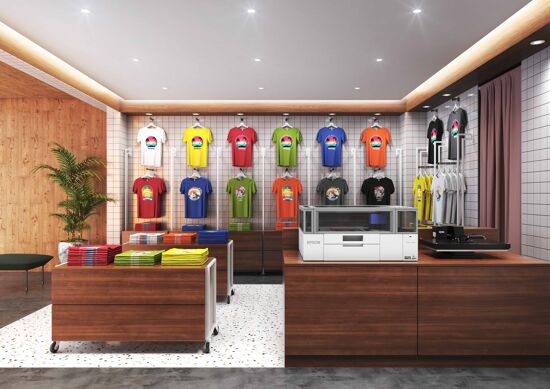Sustainable Manufacturing Insights, Developments, Software and Automation

As we enter the gates of an age of compliance, regulation and certification are now paramount. What we manufacture, the materials we choose, and the technology utilised must be worthy of the finest microscopic interrogation. Transparency and Traceability are the new norm and are now integral to the print supplier’s workflow.
Conforming to this level of scrutiny poses a huge challenge for the Textile printing community where supply chains are complicated, and both extensive and global. But comply we must if we are to expand our businesses and invest to survive the next decade.
The need for sustainable manufacturing solutions is real and imminent.
It's telling that whilst global trends on traditional fibres show a slowdown in raw consumption, the market for environmentally sourced, responsible materials is booming with the sustainable fabrics market size estimated to be worth USD 69.5 billion by 2030 at 12.50% CAGR – Report by Market Research Future (MRFR)
Machine sales are also on the increase, a sure sign that the Textile industry is beginning the mammoth journey to digitisation. Reequipping for environmentally secure production is finally mainstream and opportunities abound for technology providers and the businesses they serve. The global digital textile printing machine market size was valued at USD 191.90 million in 2020, and is projected to reach USD 522.92 million by 2030, growing at a CAGR of 10.4% from 2021 to 2030.
 Caption: “The printing process with pigment inks is direct and doesn't require coating and finishing operations, such as steaming and washing, delivering vibrant colours and perfect softness for just-in-time delivery or sewn manufacture – importantly - using waterless printing process”. D.gen Credit: D. Gen
Caption: “The printing process with pigment inks is direct and doesn't require coating and finishing operations, such as steaming and washing, delivering vibrant colours and perfect softness for just-in-time delivery or sewn manufacture – importantly - using waterless printing process”. D.gen Credit: D. Gen
Supporting the machinery marketplace of course is a global industry that provides consumables, software and automation technology. Innovations are thick and fast, as is certification if we are to provide transparent supply chains that meet the numerous regulatory reforms that are in draft or now enforced across the globe. Here to lies a new territory for the supplier, when meeting the stringent regulatory reforms of the continents and the customers we supply.
The age of compliance is here, and its impact will shape the future of Textile printing machinery, consumables, software and automation technologies.
The sprint to certification is critical as our consumers measure and document every element of the final products DNA. Keeping up with such certification at every step of the products manufacture and development is equally tasking and doing so often demands that we zig-zag our supply chain across many continents. In truth, whilst our customers seek to re-shore or nearshore their final products, the manufacturing components of the technologies and consumables we utilise are sourced worldwide.
The only way to succeed in this challenging marketplace is to strengthen supplier relationships. Investing in our stakeholders, regardless of their position in our vendor chain - is paramount. Each and every stakeholder has a key part to play, and the weakest link will ultimately collapse the strongest chain.
Time is of the essence, and contracts are now won and lost on transparency. Informing and educating our customers is critical to every commercial success. There is a lot to learn, in a very short timeframe, and no one person has all the answers. As we enter an age of compliance, we also enter an age of collaboration and communication. Across the supply chain we must transfer knowledge and build strong, open relationships with our technology providers to secure a vibrant future for printing industry.
Looking at progress made across the sector in companies large and small, here we highlight just some of the recent developments of note as we move forward towards a circular economy that provides a rich tapestry for innovation and environmentally responsible manufacturing process:
Starting with materials: Communicate fibre authenticity with support from the Lenzing E-Branding Service. Lensing continues their exemplary progress to couple ongoing efforts to ensure traceability, going one step further with the introduction of an E-Branding Service platform that provides value-added service and support to the value chain. Developed as a one-stop online solution, the Lenzing E-Branding Service platform enables customers along its value chain and brand partners to apply for fabric certification and product licenses and download brand assets for marketing purposes.
Fibre verification is a key component of the E-Branding Service platform as it requires internal testing of the fabrics to assure authentic TENCEL™ branded fibres are used. With the fabric certification number, users of the E-Branding Service platform can apply for product licenses to use TENCEL™ brand assets for product labelling or promotional content.
Apart from readymade product hangtags for in-store promotions, in line with the increase in online shopping, Lenzing also offers a Digital Hangtag tool on the E-Branding Service platform, so brands can help consumers easily find products made with TENCEL™ branded fibres, learn more about the garment and make informed purchase decisions when shopping online. Everything is done online via the E-Branding Service platform, allowing partners to use its services anytime anywhere.
 Caption: “The age of compliance is here, and its impact will shape the future of Textile printing machinery, consumables, software and automation technologies” Debbie McKeegan – FESPA Textile Ambassador. Credit: Fashion Compliance
Caption: “The age of compliance is here, and its impact will shape the future of Textile printing machinery, consumables, software and automation technologies” Debbie McKeegan – FESPA Textile Ambassador. Credit: Fashion Compliance
FibreTrace dive deep into transparency with new digital blockchain solution. Approx. 60% of fashion consumers want more transparency about the production journey of their clothes. FibreTrace, has released a free digital traceability solution to the textile industry, which maps the global textile supply chain from fibre to retail. The platform provides transparency in one easy to use, globally accessible platform with no fees attached, eliminating the barrier to transparency for producers, manufacturers, brands and retailers.
Currently, 50% of the world’s largest fashion brands continue to disclose little or no information about their supply chain. However, transparency has become a priority on political agendas and legislative development from the USA’s Fabric Act to the The Sustainability Pledge of the UNECE (United Nations Economic Commission for Europe), Geneva/Switzerland.
“The lack of accountability within the textile industry has left the door wide open for social and environmental neglect and misconduct” commented
Shannon Mercer, Chief Executive Officer, FibreTrace.
Powered by Blockchain technology from one of the global leaders in traceability technologies, FibreTrace, based in Singapore, FibreTrace Mapped provides a digital centralized chain of custody for unlimited users. Unlimited accessibility is available due to the cloud-based software solution, with the functionality to upload order and shipping documentation, and incorporate existing environmental and social compliance credentials.
The platform is system agnostic and can integrate with various product and data management systems and tools and allows users to set up their company profile, add colleagues, register their own sites, and invite partners across the supply chain. FibreTrace Mapped works with any fibre, material, certification, document, data and integration, in one intuitive system where all information is protected, private and secure. For enhanced traceability, FibreTrace Verified combines physical tracing technology with the digital platform to provide trust, verification and authenticity of fibre.
Focussing the lens onto Transparency in Fashion from Fashion Revolution with the seventh annual edition of the Fashion Transparency Index. This year, 250 of the world’s largest fashion brands and retailers were reviewed and ranked according to what information they disclose about their social and environmental policies, practices and impacts, in their operations and supply chain.
This Index is a tool to push and incentivise the world’s largest fashion brands to be more transparent about their social and environmental efforts. Fashion Revolution believes that transparency is foundational to achieving systemic change in the global fashion industry, which is why they have been campaigning for it since 2014, and why they created the Index.
 Caption: “The explosion of business and technology in the last decade puts a serious strain on the global environment. This depletion of resources and the harming of the environment is causing a significant shift in society: a shift toward sustainability. This includes a demand for sustainable clothing.” Tukatech. Credit: NONE
Caption: “The explosion of business and technology in the last decade puts a serious strain on the global environment. This depletion of resources and the harming of the environment is causing a significant shift in society: a shift toward sustainability. This includes a demand for sustainable clothing.” Tukatech. Credit: NONE
“Transparency is a first step; it is not radical, but it is necessary. When brands publicly disclose information, it allows anyone to scrutinise their policies, hold them accountable for their claims and advocate for positive change.
Transparency is not to be confused with sustainability. However, without transparency, achieving a sustainable, accountable, and fair fashion industry will be impossible.” Fashion Revolution.
How is the printing machinery industry evolving to address sustainable manufacturing?
In the world of sustainable textile printing, Bruno Ruggiero, the International Sales Director of d.gen of South Korea, signposts the advance of waterless printing technologies. D.gen recently announced the launch of the all-new Artrix H8 with CBS Technology from d.gen.
Showing its capability to print in a single pass with pigment inks, the d.gen Artrix H8 uses CBS (pre-treatment by print heads) Technology ensure that the in-line fixation system helps reduce costs and increase profitability by speeding up the printing process.
Artrix is the ultimate platform for direct printing on fabrics at professional level with its pigment inks and CBS (pre-treatment by print heads) which gives even more durability and deep colours on natural materials such as cotton, linen, viscose. Thanks to its high productivity, automation options and the sticky-belt feeding system, graphic users and industrial textile businesses can easily print on woven and nonwoven fabrics, such as cotton, polyester, Tyvek, rayon, velvet and more.
The printing process with pigment inks is direct and doesn't require coating and finishing operations, such as steaming and washing, delivering vibrant colours and perfect softness for just-in-time delivery or sewn manufacture – importantly - using waterless printing process.
Looking at how we design using CAD/CAM by example: Tukatech stated “Sustainable clothing is more than a trend. It’s a movement driven by consumers and brands/designers alike, passionate about the ethical, social, and environmental implications of clothing design. CAD supports the essential pillars of the sustainable design movement — in more ways than you expect. The explosion of business and technology in the last decade puts a serious strain on the global environment. This depletion of resources and the harming of the environment is causing a significant shift in society: a shift toward sustainability. This includes a demand for sustainable clothing.”
Reducing Waste. Often misunderstood - Ethical fashion is the idea that people within the fashion industry need to be treated fairly. Several major brands have come under fire in recent years over the working conditions they provide in their factories. Ethical fashion fights for these conditions to improve.
One of the components of ethical fashion is also cutting down waste. This means waste that is created as a by-product of the manufacturing process. It also pertains to waste material from the process itself such as excess fabric. Part of why so much excess fabric is created in fashion design is because of improper markers being made. Technological advancements, like Tukatech’s SMARTmark , help to keep textile waste to a minimum.
Ethical fashion also demands that designers and clothing companies participate in fair trade. Designers focusing on sustainable fashion adopt a policy of circular fashion as well. “SMARTmark along with Tukacut is a great example of how the fashion industry is using CAD to improve sustainability. With exact, computer-generated cuts, not as much fabric goes to waste. Decreasing designers’ impact on the environment”.
There can be no doubt that our industry is now sprinting towards a digital future, but all stakeholders need to comply. Each and every textile practitioner has a part to play in this complicated supply chain. It’s a long journey, and an uphill challenge, a challenge that is evolving at an unprecedented pace.
There can be no rear-view mirror, success can only be achieved by changing the consumers buying behaviour and in providing all textile markets good access to on-demand sustainable textile manufacturing solutions.
Topics
Interested in joining our community?
Enquire today about joining your local FESPA Association or FESPA Direct
Recent news

The importance of Personalisation in Direct Mail - The Power of Print
Jeroen van Druenen, CCO of Jubels discusses how personalised direct mail, especially print, boosts engagement and ROI by tailoring content to individual recipients. Using variable data printing (VDP), marketers create unique designs and offers, enhancing relevance and fostering stronger customer relationships. Physical mail's tangibility and lasting impact further amplify personalisation's effectiveness.

What are the current trends for digital screens?
Digital screens are evolving rapidly, moving beyond simple signage. MicroLED technology improves resolution and efficiency, while 3D and AR displays offer immersive experiences. AI is transforming content creation and analytics, personalising interactions and optimising screen placement. Larger, wall-sized screens and temporary rentals at events are becoming more common. As screens become ubiquitous, innovation focuses on eye-catching solutions to maintain audience engagement.

Hints and tips for vehicle wrapping success
While rising demand for vehicle wrapping is good news for the industry, this is placing more pressure on companies to deliver quality work at a solid pace. Here, Rob Fletcher picks up some tips from several experts in this sector to help wrappers operate smoothly.

What are the opportunities in Personalisation for Sportwear and Signage?
Rob Fletcher discusses the growing importance of personalisation and digital innovation across sectors. Major brands use personalised print to engage customers and boost sales. Personalised sportswear demand is increasing, and companies like Eurojersey embrace sustainable manufacturing and digital transformation.